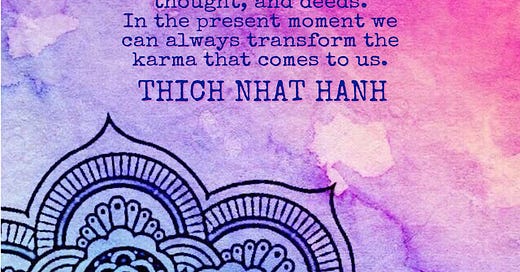“I am the owner of my karma. I inherit my karma. I am born of my karma. I am related to my karma. I live supported by my karma. Whatever karma I create, whether good or evil, that I shall inherit.”1
“Kamma in the way the Buddha taught it means skillful or unskillful action—something that we do now. It’s the active aspect of a cause and effect process known as kamma-vipaka, in which vipaka or ‘old kamma’ means the effect, the result of previous actions.’ ”2
“As ‘action,’ kamma supports choice. We can choose what actions we undertake. . . Kamma centers on your current intention or ‘volition’ (cetana). The teachings on kamma therefore encourage a sense of responsibility for action; the responsibility to give attention to the many conscious and half-conscious choices in terms of what we do.”3
“The principles of kamma link ‘external’ behaviour to the ‘internal’ practice of meditation. And that meditation is one of a kind kamma—the kamma that leads to the end of kamma. In fact, kamma and the end of kamma is a useful summary of what the Buddha had to offer as a path to well-being and to Awakening.”4
“Through an inclination called ‘becoming,’ kamma forms something like a psychological genetic code. This code, which is the pattern of each individual’s kammic inheritance, is formed through dynamic processes called sankhara. Like one’s personal genetic code, the sankhara retain our kammic blueprints, and so from day to day we remain the same person in relative terms.”5
“Variously translated as ‘formations,’ ‘volitional formations,’ [and] ‘fabrications,’ [Ajahn Sucitto] renders sankhara as ‘programs and patterns.’ Some of these programs are functions, such as metabolism, that are bound up with the life-force (ayusankhara); some are carried by the consciousness that is generated from previous lives; and some are formed from through this-life interactions.”6
“The most significant programs from the point of view of transmigration are those that weave grasping onto body and mind. These are three ‘outflows’—the outflow that bonds to sense-input with feelings ranging between delight and aversion; the outflow of ‘becoming’ that generates the sense of an autonomous self; and the outflow of ignorance that obscures the truth about samsara [the endless cycle of birth and death.]”7
“Kamma means ‘action’ in a more than physical sense; it also includes verbal action . . . and includes the ‘internal speech’ of thinking. But actually, the kamma of our emotive responses—‘mental’ (or ‘heart’) kamma—is the strongest. Responses—and the inclinations that they’re based upon—govern the actions of body and speech, and also engender results in the domain of emotions, attitudes, and mind-states.”8
“In its fullest sense, liberation from kamma is liberation from cause and effect in the mind. It’s a process of mentally, emotionally, stepping back from any state and seeing it just as a state without reactions and attitudes. This simple skill . . . is what we develop in Buddhist practice. More radically, it means stepping out of the program that asserts that my life gets fulfilled by having or being some state or another.”9
“Monks, these four types of karma have been directly realized, verified, & made known by me. Which four? There is karma that is dark with dark result. There is karma that is bright with bright result. There is karma that is dark & bright with dark & bright result. There is karma that is neither dark nor bright with neither dark nor bright result, leading to the ending of karma.”10
Anguttara Nikaya v.57
Sucitto, Ajahn. Kamma & the End of Kamma. Amaravati Publications, 2008.
Ibid.
Ibid.
Ibid.
Ibid.
Ibid.
Ibid.
Ibid.
Anguttara Nikaya, 4.235




